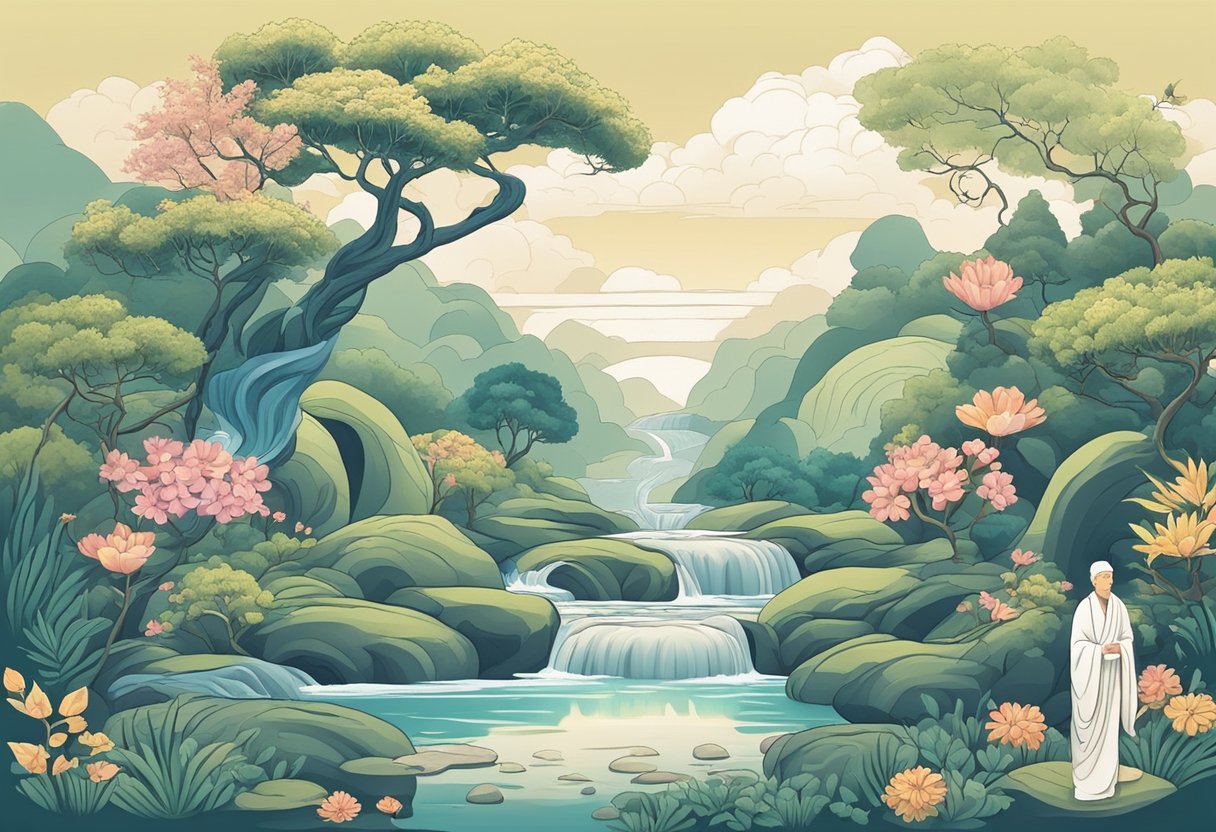Stoicism and Taoism are two influential schools of thought that offer insights into leading a harmonious life.
While originating from very different cultural backgrounds—Stoicism from ancient Greece and Rome, and Taoism from ancient China—both philosophies provide a framework for personal development and understanding one’s place in the world.
They engage with themes of virtue, the flow of life, and the cultivation of an inner tranquility, guiding individuals towards a life of balance and wisdom.


Despite their differing approaches to certain philosophical questions, such as the nature of the universe and the means of achieving a virtuous life, Stoicism and Taoism converge on the importance of aligning oneself with the natural order of things.
They also emphasize the cultivation of the self and the management of one’s emotions and desires.
Recognizing that life is fraught with challenges, both philosophies encourage adherents to focus on what is within their control and to accept what is beyond it with equanimity.
Key Takeaways
- Stoicism and Taoism provide philosophical guidance for achieving balance and wisdom in life.
- Both schools of thought emphasize self-cultivation, management of emotions, and living in accordance with nature.
- While originating from different cultures, Stoicism and Taoism share intersecting themes and practices.
The Origins and Principles of Stoicism


Stoicism is an ancient philosophy that teaches the development of self-control and fortitude as a means to overcome destructive emotions. The philosophy holds that becoming a clear and unbiased thinker allows one to understand the universal reason (logos).
The Role of the Individual in Stoicism
Stoicism asserts that virtue, such as wisdom and self-discipline, is the only good.
For individuals, the core objective is achieving eudaimonia, a state of contented well-being led by reason.
Adherents believe in focusing only on what they can control while remaining indifferent to what they cannot, a concept known as the dichotomy of control.
The Founders and Key Philosophers
Zeno of Citium is recognized as the founder of Stoicism, which arose during the Hellenistic period in Ancient Greece.
His teachings were later developed by philosophers like Epictetus, a sage who highlighted the importance of internal freedom through self-mastery.
Marcus Aurelius, the Roman Emperor, embodied Stoic principles and rationality in his governance and personal reflections.
Stoics revere the sage, a philosopher who aspires to live according to the virtues of the rational intellect.
The Origins and Principles of Taoism


Taoism is an ancient Chinese philosophy centered on living in harmony with the Tao, a principle signifying ‘the way’ or the essential, unifying force of the universe.
Rooted in the works of seminal figures like Lao Tzu, it encapsulates the pursuit of spiritual immortality and balance through aligning with the natural order.
The Concept of Tao in Taoism
Tao, or ‘Dao’, is the foundational concept in Taoism.
It is often translated as “the Way,” but this is a simplification of a complex idea that defies complete translation.
The Tao is the ultimate creative principle of the universe. All things are unified and connected through the Tao.
It represents the source, pattern, and substance of everything that exists.
Taoism suggests that the Tao is both the driving force and the goal of all life; by aligning with it, one achieves harmony and balance, embodying the principle of Wu Wei—effortless action or non-action.
- Yin and Yang: To describe the nature of reality, Taoists use the concept of Yin and Yang, representing opposite yet complementary forces that constantly interact, never existing in absolute stasis but in a dynamic equilibrium.
- Wu Wei: Recommends a way of being where actions are in alignment with the ebb and flow of the elements of the cosmos; it implies not forcing but instead doing that which comes most naturally and thus achieving with least effort.
Influential Taoist Thinkers
Lao Tzu is traditionally regarded as the father of Taoism.
He is said to have authored the seminal text of Taoism, the Tao Te Ching, which discusses the ways through which a sage can lead by following the natural order of the world.
Its philosophy promotes simplicity, humility, and moderation.
Another influential sage, Zhuangzi (Chuang Tzu), expanded on these teachings and underscored the relativity of human perceptions—how one’s understanding of the universe depends on one’s own natural conditions.
These thinkers laid the groundwork for Taoism by examining the nature of existence and the essence of morality, proposing that true wisdom lies in observing and understanding the underlying flow of life, rather than in obvious knowledge or active striving.
- Lao Tzu: Emphasized the importance of naturalness and simplicity in one’s actions and attitudes.
- Zhuangzi: Challenged traditional beliefs and suggested that one can achieve a full understanding of the Tao through spiritual contemplation and connection with nature.
Central Concepts in Stoicism and Taoism
Stoicism and Taoism both focus on achieving a harmonious life through understanding the limits of control, the pursuit of virtue, and the essence of nature.
Understanding Control and the Art of Letting Go
Both Stoic and Taoist thought emphasize the importance of understanding what is within our control and what is not.
The Stoic concept of the Dichotomy of Control categorizes things as either within one’s control (such as one’s own thoughts and actions) or outside one’s control (like the behavior of others or external events).
Practitioners are encouraged to focus their energy solely on the former and practice acceptance of the latter.
Meanwhile, in Taoism, this principle is echoed through the notion of Wu Wei, or non-action, which suggests that one should align with the natural flow of life rather than exert force upon it.
This surrender to the rhythms of nature promotes a peaceful state of being.
The Pursuit of Virtue and Inner Harmony
In both philosophies, the development of personal virtue is central to achieving inner peace and harmony.
Stoicism identifies four cardinal virtues: wisdom, courage, justice, and temperance, which together lead to a virtuous life marked by rationality and self-control. For Stoics, virtue is the only good and is sufficient for happiness.
Taoism, with a more abstract approach, considers virtue (or “De”) as the inherent character aligned with the Tao, or the way of the universe.
Cultivating inner harmony involves balancing Yin and Yang—opposing forces that are interconnected and interdependent within the natural world.
Comprehending the Natural World
Understanding and living in accordance with nature are both key tenets in Stoicism and Taoism.
For Stoics, rationality is what distinguishes humans, and it is by using reason that one can align with nature’s rational and orderly process.
Stoicism equates nature with the natural reason apparent in the universe.
In contrast, Taoists believe in the fundamental balance of all things as manifested in the Dao, which signifies the essential, unchanging reality underlying the natural world.
Embracing this concept entails self-reflection and surrender to the natural world, trusting that life unfolds in its own time and rhythm, thus embodying wu wei and maintaining balance with the natural order.
Stoicism and Taoism in Practice
Stoicism and Taoism offer actionable philosophies for navigating life’s complexities with discipline, simplicity, and resilience.
Overcoming Life’s Challenges with Stoicism and Taoism
Both Stoicism and Taoism provide tools for individuals to face life’s challenges with greater resilience and equanimity.
Stoicism teaches the importance of courage and discipline, advising one to focus only on what is within their control.
Following Stoic principles, a person may learn to separate external events from their internal responses, effectively turning obstacles into opportunities for personal growth.
In similar ways, Taoism encourages simplicity and patience, emphasizing the concept of Wu wei — effortless action — which guides one to align with the natural flow of life.
The Taoist approach promotes contentment and a harmonious relationship with the natural world, accepting and flowing with life rather than resisting it.
Applying Wisdom in Daily Living
The practical wisdom from Stoicism can be applied in daily life through deliberate practices such as reflection and meditation, enhancing one’s ability to make rational decisions and live virtuously.
Stoics regularly engage in exercises that foster self-control and an appreciation for what they have, leading to a life marked by contentment and emotional intelligence.
Similarly, Taoism offers guidance on leading a balanced life, stressing the importance of living simply and authentically.
It teaches adaptability and letting go of rigid expectations, encouraging followers to live in harmony with the Tao, or ‘The Way’, which is understood as the underlying natural order of the universe.
By embodying these principles, individuals navigate daily complexities with a wise and steady heart.
Intersecting Themes between Stoicism and Taoism
Stoicism and Taoism, two ancient philosophies, converge on several themes that encourage personal growth and inner peace. Key among these are the pursuit of tranquility and the strategic release from the grip of desire.
Tranquility and the Acceptance of Fate
Both Stoicism and Taoism place a significant emphasis on tranquility as an ideal state of being.
Stoics stress the importance of maintaining a calm disposition in the face of life’s challenges, advocating that one should not be swayed by emotions or external circumstances.
They believe that serenity is achieved through the acceptance of fate – whatever happens is necessary and outside of personal control.
Similarly, Taoism seeks harmony with the Tao, or the way of the universe, which teaches acceptance of the natural order and flow of life to maintain inner peace.
Freedom from Desire
The Stoic and Taoist paths to freedom converge in their treatment of desire.
Stoicism advises that true liberation is found in overcoming desires and attachments, which are the root cause of suffering and distress.
Through the use of reason, they strive to separate what is within one’s power from what is not, and to detach from the latter.
On the other hand, Taoism emphasizes the need to surrender personal ego and material pleasures in order to align with the Tao, advocating for simplicity and an absence of fear and desire as means to achieve a state of effortless being.
Modern Applications and Interpretations
In a world increasingly seeking balance and inner peace, Stoicism and Taoism have found new relevance.
These ancient philosophies are now applied in various aspects of modern life, helping individuals navigate the complexities of the 21st century.
Stoicism, Taoism, and Contemporary Mindfulness
Modern Stoicism has sparked significant interest, integrating core aspects of ancient teachings with contemporary mindfulness practices.
Individuals are drawn to Stoicism’s focus on personal virtue and the practice of mindfulness as tools to maintain mental clarity and resilience in today’s fast-paced world.
Websites such as Modern Stoicism provide resources that demonstrate how Stoic principles can be fused with mindfulness to cultivate a reasoned and harmonious life.
Similarly, Taoist concepts like unity and harmony with nature resonate with mindfulness practices, advocating a serene approach to living.
Taoism’s principles of accepting reality and acting with intention rather than force align closely with the non-judgmental awareness cultivated through mindfulness.
The serene essence of Taoism in the recognition of life’s impermanent nature is echoed in the philosophical meditations of contemporary mindfulness.
Balancing Ambition and Serenity Today
In the domain of modern life, where ambition often supersedes serenity, the intersection of Stoicism and Taoism provides a framework for balance.
Stoicism encourages the development of self through discipline and rational thought, emphasizing that one’s true ambition should lie in cultivating personal virtue rather than seeking external success.
This Stoic perspective is especially relevant in today’s society, where success is frequently defined by material gain.
Taoism complements this by offering a way to live in unity with the natural world, reminding individuals that harmony and serenity stem from aligning with the Tao—the way of nature.
It presents an understanding of ambition not as a pursuit of external milestones but as a personal journey toward spiritual alignment, as explored in discussions about Taoist philosophy.
This ancient wisdom is applied to help individuals balance their life’s ambitions with the search for inner peace.
Connecting with the Self and the Universe
In both Stoicism and Taoism, the journey towards wisdom involves recognizing the deep interconnectedness between the self and the universe. This connection informs the pursuit of balance and unity within the natural order.
The Interconnectedness of Self and Nature
In the worldview of Stoicism, the self is viewed as inherently part of the greater cosmos. This philosophical tradition emphasizes that human beings are fundamentally connected to the rest of nature through a universal reason, or logos.
They suggest that understanding this natural order is key to living a fulfilled life.
Taoism also places a significant focus on the connectedness of all living things.
It introduces the concept of yin and yang, representing the harmonious balance in nature and within individuals.
It promotes living in accordance with the Tao, or the way, which is understood as the essential, unifying force of the universe.
Exploring the Spiritual Path in Stoicism and Taoism
Stoics employ rationality to align themselves with what they identify as the natural order of the universe.
This practice is aimed at fostering wisdom and inner tranquility by accepting things that cannot be changed, thus achieving balance within oneself.
Conversely, Taoism encourages a path of spontaneity and intuition, suggesting that wisdom comes from embracing the natural flow of life.
Rather than forcefully applying rationality to align with the universe, Taoists advocate for a passive, yet deeply engaged approach to life, allowing the interconnectedness of all things to guide one’s actions harmoniously.
By observing these paths, both Stoicism and Taoism offer ways to connect with one’s self and the universe, pointing towards a state of being that is in tune with the ebb and flow of life’s energies.
Philosophies Compared with Other Traditions
To understand Stoicism and Taoism, it is illuminating to compare these philosophies with Buddhism, to highlight their unique positions within the broader spectrum of Eastern and Western thought.
Stoicism and Taoism versus Buddhism
Stoicism, an ancient Greek philosophy, encourages the development of self-control and fortitude as a means to overcome destructive emotions.
In contrast, Buddhism addresses the cessation of suffering through the Eightfold Path and the Four Noble Truths, focusing on mindfulness, ethical conduct, and wisdom.
While Stoicism emphasizes rigorous logic and the acceptance of fate, Buddhism often includes a more metaphysical approach to understanding the nature of reality through concepts such as anatta (non-self) and sunyata (emptiness).
Taoism shares certain similarities with Buddhism, particularly in the pursuit of harmony with the natural world.
However, Taoist philosophy differs in its foundational principle of the Tao, or the Way, which is a natural order spontaneously arising without effort.
Conversely, Buddhism’s approach, especially within the Zen tradition, often involves disciplined meditation and mindful practice to achieve enlightenment and inner peace.
Distinguishing Eastern and Western Perspectives
Stoicism and Taoism’s approaches to life’s challenges highlight a key difference between Eastern and Western philosophy.
Western philosophies like Stoicism are characterized by an analytic and structured approach to achieving happiness through virtue and reason.
In contrast, Eastern philosophies such as Taoism advocate for spontaneous living, being rather than doing, and finding contentment in the natural flow of life.
While both seek harmony and contentment in life, Stoicism tends to involve active participation and dutiful engagement in society, whereas Taoism suggests a more passive alignment with the ebb and flow of the cosmos.
Both philosophies provide valuable insights into the universal quest for happiness and contentment, although their methods and emphases reveal the rich diversity of philosophical thought across cultures, emphasizing different paths to similar goals—a testament to the profound common ground shared by varying traditions in the pursuit of philosophy and religion.
Contemplation of Mortality and the Virtuous Life
Stoics and Taoists share a profound respect for living a virtuous life, seeing it as the path to contentment and happiness. Central to both philosophies is the contemplation of mortality, which acts as a compass guiding moral behavior and attitudes towards life.
Stoicism and Mortality:
- Stoics focus on mental tranquility and gratitude.
- They view death as the ultimate test of virtue, emphasizing qualities such as courage and justice in the face of adversity.
- Meditating on death is not seen as morbid, but as a means to appreciate life’s transient nature and live fully.
Taoism and Mortality:
- Taoists advocate living in harmony with the Tao, or ‘the Way,’ which includes accepting the natural cycle of life and death.
- They seek to achieve a state of simplicity and spontaneity, embodying the virtue of living in accordance with nature.
The Virtuous Life:
- Both philosophies hold that virtue is the highest good.
- Living virtuously, be it through Stoic self-control or Taoist simplicity, is believed to lead to contentment and happiness.
- Acts of justice and wisdom are seen as aligned with the natural order of the universe.
In practicing these principles, adherents find the strength to remain steadfast amidst life’s challenges, the tranquility to face mortality, and the clarity to pursue a life well-lived.
Conclusion
Stoicism and Taoism, both ancient philosophies, offer perspectives on living a life of harmony and virtue. They identify a common path to inner peace: living in accordance with nature and accepting life’s impermanence.
Stoicism focuses on self-discipline and rationality, encouraging individuals to act in service of the greater community. In contrast, Taoism emphasizes spontaneity and aligning oneself with the Tao, or the way of the universe.
Despite their different origins, one in the Hellenistic period of Greece and the other in ancient China, they converge on key teachings about virtue and mindfulness. Both philosophies recognize the influence of external chaos on the human condition and promote an interior life that remains undisturbed by external events.
The practical applications of Stoicism and Taoism are timeless, providing guidance on ethical living and emotional resilience. Their principles continue to resonate in modern society, underscoring the universal search for meaning and well-being.
Philosophical exploration reveals that Stoicism and Taoism, while distinct in their approaches, share a dedication to personal growth and harmony. This view is substantiated by the exploration of their common themes and the ways in which they diverge in their paths to wisdom.
The cross-cultural examination of these teachings enriches the understanding of universal human values, suggesting that different philosophical traditions can lead to similar conclusions about the good life.
Frequently Asked Questions
This section addresses the distinctions and parallels between Stoicism and Taoism—two philosophical systems with unique perspectives on life, virtue, and nature.
What are the key philosophical differences between Stoicism and Taoism?
Stoicism emphasizes rational understanding and active participation in life’s duties, whereas Taoism advocates for a harmonious flow with the natural order, often through non-action or wu wei. While Stoics believe reason is essential to virtuous living, Taoists focus on aligning with the Tao, a guiding principle that is not fully definable.
How do Stoicism and Taoism compare in their approach to living a virtuous life?
Both Stoicism and Taoism value inner harmony and personal ethics, though their methodologies differ. Stoicism suggests that virtue is attained through living in accordance with nature and reason, while Taoism proposes that virtue arises from living in alignment with the Tao, emphasizing spontaneity and naturalness.
Can the practices of Stoicism enhance the understanding of Taoist principles?
Stoicism, with its focus on self-control and self-awareness, can complement Taoist practices of simplicity and flexibility. The cultivation of a tranquil mind is fundamental to both philosophies and can lead to deeper insights into the nature of existence.
In what ways do the concepts of nature and cosmology diverge between Stoicism and Taoism?
While both Stoicism and Taoism see nature as a key aspect of life, Stoicism views the natural world as a manifestation of rational order. Meanwhile, Taoism perceives nature as a reflection of the Tao, inherently mysterious and fluid.
What are the similarities in ethical teachings between Stoicism and Taoism?
Stoicism and Taoism both promote living in accordance with nature, self-improvement, and the development of virtues like wisdom and compassion. They share a profound emphasis on harmony and balance in life, despite their diverse viewpoints on the cosmos.
How is the concept of balance addressed differently in Stoicism and Taoism?
Stoicism encourages balance through self-discipline and rational thought. It aims to maintain equanimity despite external circumstances.
Taoism, on the other hand, approaches balance by embracing the way of water. It suggests that one should adapt and yield to life’s natural flow without resistance.





